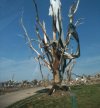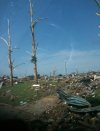I’m no expert by any means but I’ve heard this from external sources more qualified than me, so take what I say with a grain of salt. The reasoning behind why the sort of gouge scouring shown in the video above isn’t as impressive as some other examples of it, to start, is because of the isolated nature of it alongside the fact that it’s shaped the way it is. The scouring there is in the shape of an “eye” - that it was more likely caused from the fact that it was simply a weaker layer of soil being lifted off the ground, like a peeling sheet. It isn’t a streak, it’s a mat of soil, and it follows the motion of the vortex pretty weakly. Compared to gouge scouring like that saw in Philadelphia or Smithville, it isn’t a trench that is following the motion of the vortex, which to me points to the sheer strength of it drilling into the ground. That’s what Philadelphia and Smithville were. The trenches they formed were up to hundreds of yards long and more than a foot deep, and coincided with clear EF5 damage or EF5 level contextuals. This example did not do such a thing (although the tornado may still have been at HE EF4 level or even EF5 level here regardless, it’s definitely more nebulous though). I’m of the opinion that Western Kentucky was no doubt an EF5 level tornado, but the reasons I have for it being one don’t involve the trenches it dug here.
Also, I’m unsure about the quality of the soil in the area it did this. There’s (supposedly) been research done on the soil in the south to verify if Philadelphia’s trench scouring was EF5 level - it’s a very strong clay that was used in cattle pasture and was particularly resistant to outside stresses, from what I have heard.
@Sawmaster is someone who is much more qualified than me to discuss/talk about this. At the very least, it’s pretty much been confirmed that even if the soil isn’t as strong as we think, it still takes a baseline EF5 to do what it did, although I’m leaning towards a higher end EF5 being required to dig the monster trench it did. There are some people who disagree with this notion on this forum and their opinions are valid as well, it’s just something that is particularly hard to understand without further research into the topic.
Also, I see consistent grass scouring like that seen in Chickasha 2011 or the further sections of the Western Kentucky tornado’s path (Bremen and Dawson Springs) as more impressive than the trench digging there, as that is less dependent on soil strength and is a more consistent indicator of very high end tornado strength than trench digging is. There’s supposedly been EF2 tornadoes that have dug trenches (again, probably weaker soil, and also I can’t name any off the top of my head) and trench digging practically requires extraordinary examples/evidence to point to a high end tornado, like that seen in the 2011 Super Outbreak.
And to answer your question, I believe Jarrell’s ground scouring was the most intense you will ever see. I do believe Jarrell was every bit as strong as Smithville was and moved extremely slow which not only contributed to the exaggerated nature of the damage, but also its breadth.









